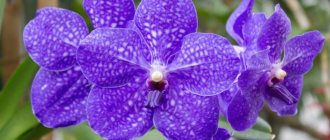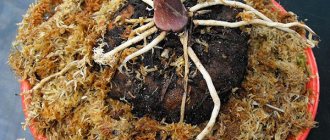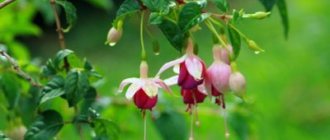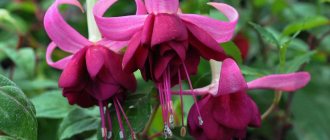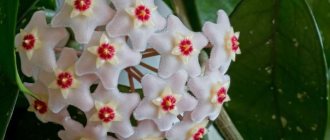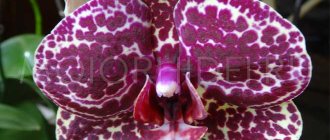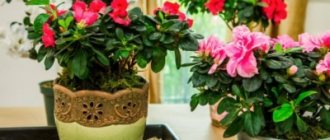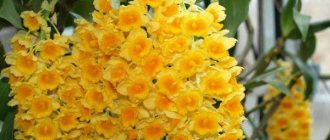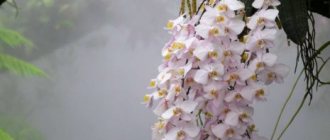The dense paniculate inflorescences that delight the eye of the exotic cymbidium orchid are very popular in composite bouquets. However, domestic flower growers know little about the incredibly beautiful old English varieties and cut hybrids obtained as a result of crossings, but they are not so difficult to grow at home.
Beautiful exotic cymbidiums are especially picturesque when grown in a canopy: a cascade of long peduncles, densely strewn with large porcelain flowers, falls in a lush fragrant wave over the edge of the flower container.
Under natural conditions, the cymbidium orchid grows in the warm, humid tropical forests of Burma, Northern India, Thailand, and islands near Australia and Indonesia. Almost all plant species live on the soil or in thick accumulations of humus between tree branches or on horizontal shoots.
Cymbidiums have been known in culture for approximately 2 thousand years. The ancient Chinese philosopher and politician Confucius called amazing plants “kings of fragrances.” The genus Cymbidium was first described by the Swedish botanist P.W. Svarts at the turn of the 18th and 19th centuries.
Choice when purchasing
When choosing an indoor orchid, you should pay attention to its condition:
- The root system must be well developed. The flower is sold in transparent pots, so it will not be difficult to see it. The roots of a healthy plant are olive-colored and fleshy. Bright green tips indicate an active growth phase. Aerial roots are elastic.
- The leaves are dense, light green in color. The edges of the leaf blade have a reddish edging. There should be no stains, deposits or spots on the surface. Do not buy a plant with wrinkled, limp leaves or dark green or reddish hues.
- Choose a flower that has open flowers and buds. The greater their number, the better.
- The growing point of a healthy flower is firm to the touch and elastic.
Read all the information about the types and varieties of cymbidum, of which there are more than fifty, in this article.
Popular varieties
There are more than 100 species of Cymbidium. For growing houses, the most beautiful and undemanding ones are chosen. Among hobbyists, the most popular are several varieties of this orchid.
Eburneum. The flowers are large with a delicate scent reminiscent of lilac, and are ivory in color. The requirements for light and humidity are increased. The flowering period begins in spring.
Aloe leaf. The shoots reach a height of 40 cm. The flowers are small, up to 4 cm in diameter. The colors of the petals are light yellow and burgundy. Inflorescences cascading.
Lanceolate. An unusual species with green flowers resembling stars, up to 5 cm in diameter. The shoots on which the buds form grow up to 40 cm in height. The petals are soft green in color and the central vein is red. The flowering period begins in spring and continues for a month.
Tracey. The leaves of the plant are elongated up to 60 cm. The flowers are large, up to 15 cm in diameter, rich yellow with red veins and a fringed lip. The height of the peduncle is up to 120 cm. It is located vertically or bends in an arc. The flowering period lasts from autumn to mid-winter.
Dwarf. A miniature orchid with inflorescences up to 13 cm high. The petals are pink with a light yellow edge. The lip is white with reddish spots. The plant blooms from mid-winter.
Hybrid forms of cymbidiums, unlike natural ones, are not demanding on the conditions in the apartment. With proper care, they can grow for years, delighting with flowering and actively reproducing.
Cymbidium - mistakes in care. Video:
Cymbidium - mistakes in care
How to care for a cymbidium orchid?
Compliance with the conditions for growing an orchid and caring for it at home will allow you to get a beautiful flowering plant:
- Temperature conditions. Required temperature for flowering: +22…+24 °C. During the rest period: at night +11…+14 °С, during the day +18 °С. If the room is too hot, the flower is taken out to the balcony.
- Lighting. The plant loves bright, diffused light. Therefore, the pot is placed on the east side of the room. If it is on the south side of the window, then be sure to shade the light. In winter, when there is a lack of lighting, artificial sources are installed.
- Feeding and fertilizer. Feeding of the flower is carried out during the period of active growth of young shoots 2 times a month. They use “Tsitovit”, “Agricola”, “Flower Paradise”. Before flowering begins, potassium-phosphorus preparations are added. Do not feed during flowering. They use “Bona Forte”, “Ideal”, “Effect”, “Biomaster”, “Osmokot” and others.
Support
Young flower stalks are very fragile and can break. They need to be supported with a block. Peduncles can be distinguished from leaf primordia by their shape: when they grow to about 12 cm, they become round in diameter. From young flat sprouts only leaves are formed.
Tie a cord to the base of a young shoot, insert a support, gently press the peduncle against it and fasten them together, wrapping the cord in a spiral. Secure the upper end of the cord to the forked top of the support. As the peduncle grows in height, form new spirals, first untying the cord at the top and securing it again after the manipulations have been done.
When the peduncle reaches a height of 20-30 cm, replace the block with a support, the height of which is 3/4 of the height of the plant. The height of this orchid is 70-150 cm, depending on the variety. Split the top of the support to a depth of 3-4 cm. As the flowers open, you can replace the cord with clips or plastic adjustable garters, which will be disguised by the flowers. Do not tighten too much to avoid damaging the peduncle.
Composition of soil for growing
Suitable soil for orchids can be purchased at a garden store. It should be labeled “For Cymbidium and other terrestrial orchids”, containing bark and moss.
Expensive mixtures, in addition to the main composition, may contain pine bark, fern roots, charcoal, coconut chips, etc.
If there is no suitable substrate, then you can make it yourself. Take the components in equal parts:
- charcoal;
- fern roots;
- pine bark chips;
- broken walnut shell;
- sphagnum moss.
The main condition for suitable soil is good moisture permeability and looseness. Expanded clay is used as a drainage layer.
Read about ways to grow plants without soil at all here.
Tools
To properly replant cymbidium you will need several tools:
- a stable and hard surface on which you can safely carry out the procedure;
- correct landing capacity;
- fresh substrate (you can take one specialized for orchids);
- scissors or sharp pruning shears (for trimming rotten or wilted elements);
- solution for sterilizing instruments.
Reproduction
The orchid reproduces in several ways: by dividing the bush, by root shoots, by children, by seed. At home, choose the simplest methods:
- Root shoots. When transplanting, the tangle of roots is difficult to untangle. The roots break off, resulting in small shoots. They are placed in a new pot and sprinkled with crushed activated carbon - new shoots will grow.
- Dividing the bush. Divide the pseudobulb with roots into shoots. Transplant into a separate pot. Water deeply until roots are established and new shoots appear.
- Division of the bulb. Old pseudobulbs without roots and leaves are placed on moss, greenhouse conditions are created, and they are regularly sprayed with water. After the sprouts appear, they are transplanted into a pot.
- Reproduction by children. In order for the babies to appear, they create stressful conditions for the flower: reduce watering and place them in a cool place. After the first flower buds appear, the plant is returned to its usual care regimen. Buds that do not produce flowers will send out roots. When they grow, the baby is separated from the mother plant.
Where to place
During the flowering period, the orchid can be placed in the living room (optimum temperature 18 ^ during the day and less than 16 ^ at night). Preferably close to a window, as it is cooler there.
When looking for a location, remember that pseudobulbs must receive enough daylight for their development. When the flowers begin to bloom, you need to water the plant little by little, but regularly, to avoid drying out the substrate. After flowering ends and new shoots appear, transplant the orchid into fresh substrate.
Diseases and pests: photos, descriptions and treatment
The flower is susceptible to attack by pests and diseases if the care regimen is violated. To combat them, soak a cotton swab in a soap solution and wipe all parts of the plant. Then they spray with chemicals, for example, “Aktellik”, “Fitoverm”, a solution of garden green soap.
Frequent orchid pests: scale insects, spider mites, aphids.
Diseases and how to fight:
- Root or pseudobulb rotting. Reduce the amount of watering, replant in a new pot and dry substrate. Do not water for two weeks.
- Viral mosaic. Appears as yellow spots or brown stripes on the leaves. The disease cannot be treated; the flower must be isolated from other plants.
- Swelling of leaves. With abundant watering and low temperature in the room, growths with a watery shell form. It is necessary to increase the temperature and stop watering until the soil dries out.
- The buds are falling. Occurs due to a lack of microelements: phosphorus or calcium. The solution is to add fertilizer to the substrate.
- Leaves turn yellow or dry out. The cause may be a pest (spider mite), excess sunlight, dry air in the room, or death of the roots. Check and eliminate these causes: treat with chemicals, humidify the air, replace the pot and examine the root system.
Aphids on Cymbidium
Scale insects are a common plant pest.
Cymbidium leaves turn yellow
Which pot should you choose?
To transplant an orchid, you will need a container that will allow the plant to grow for the next 2-3 years without unscheduled transplants. So it’s best to immediately take a plastic pot with drainage holes made, which will exceed the diameter of the previous one by 3–5 cm.
If you are growing a cymbidium with a large and extensive root system, then the next pot should always be significantly larger than the previous one. But for miniature plants, you can take flowerpots 1–2 cm larger than the previous ones.
Possible problems
Doesn't bloom
The absence of flowering for a long period indicates disturbed temperature conditions and lighting. To force it to bloom, first create stressful conditions for it, and then provide optimal conditions for flowering. How to solve this problem, read this article.
The tips of the leaves turn black
The reason is that the plant was overfed with fertilizers. Dip the flower pot in water and rinse it to remove excess.
What other diseases of orchid leaves are there and how to treat them, read here.
Resuscitation without roots
Cymbidium is easy to quickly grow roots. If the flower is left almost without roots, do the following to resuscitate them:
- remove from the pot and soak in water for 2–3 hours;
- unravel the roots, removing with a knife all damaged, dry, loose roots;
- the cut ends are treated with an antiseptic, for example iodine, alcohol, garden pitch;
- dry the roots and sprinkle with charcoal, leave for 24 hours;
- After this, they are planted in a new substrate and not watered for 2 weeks.
Kinds
Cymbidium has many subspecies that differ in size, color and shape of flowers. The care and maintenance of various types of this orchid is not particularly different from the standard. The most popular varieties of cymbidium :
- dwarf;
- Ivory;
- sword-leaved;
- aloe leaf;
- perceptible;
- low;
- day;
- Tracey;
- giant.
Nothing is impossible for those who are determined to grow a cymbidium orchid at home. Of course, it is better for beginners to gain a little experience in floriculture, since these plants are quite capricious in terms of care and maintenance. But more experienced indoor plant lovers should take the risk. Follow all recommendations and standards of care, and soon your cymbidium will delight you with abundant and bright flowering.
Trimming
Regularly remove old wilted flowers, as they speed up the wilting process of new flowers, taking away nutrients for themselves. After the plant stops blooming, remove the peduncle as soon as possible: pull it towards you with a sharp movement, and it will break at a distance of 10 cm from the base.
It is very important that all pseudobulbs have enough light, including those located in the middle of the bush. After flowering, remove a few leaves from the middle if there are too many there. Just as in the case of peduncles, to do this it is enough to pull them sharply towards you.
Lack of flowering: main reasons
The lack of flowering in cymbidium may be due to a number of factors.
Care rules are often not followed
The main reasons that prevent an orchid from flowering are mistakes made during its maintenance, these include:
- lack of lighting;
- no temperature changes (day/night);
- the room temperature exceeds the optimal value – 20 °C.
Pseudobulb age
One of the reasons for the lack of flowering of cymbidium is its too young age. The old pseudobulbs have already faded, but the new ones are still too young.
PLEASE NOTE: The first flowering of an orchid is observed when the specimen reaches three years of age.
Air humidity
Cymbidiums are tolerant of low air humidity, but only at a comfortable temperature of 18-24°C. When kept hotter, the humidity around the orchid should increase to 55%. In this case, Cymbidiums can tolerate up to +45°.
With high humidity up to 70%, the orchid will develop faster.
It is most convenient to keep this type of orchid on the balcony or outside in the spring and summer. Natural temperature changes and humidity will provide Cymbidium with the required conditions.
Location
In autumn, the orchid should be on a slightly heated veranda (loggia) - the optimal temperature is less than 16 ° C, maintain it until the first flowers bloom. Cymbidium needs cool weather to bloom. The orchid should be outdoors from mid-May until the first frost. It must be located in an area that is well lit in the morning and evening hours. And during the day - in light shade. Attention! Do not place the pot directly on the ground, as snails and slugs may eat the plant. Protect the area around the pot with anti-slug granules (or cloth).
In autumn, beware of heavy rains. Place your orchid in a shelter: under the roof or under the porch canopy, for example.

